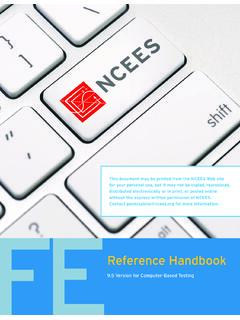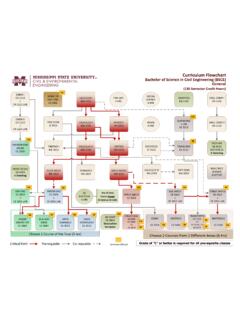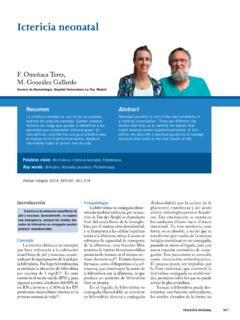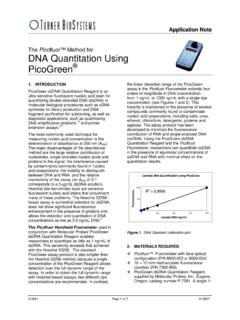Transcription of FE Reference Handbook 10.0 - Mississippi State University
1 FE Reference Handbook document may be printed from the NCEES Web site for your personal use, but it may not be copied, reproduced, distributed electronically or in print, or posted online without the express written permission of NCEES. Contact for more 2020 by NCEES . All rights NCEES material is copyrighted under the laws of the United States. No part of this publication may be reproduced, stored in a retrieval system, or transmitted in any form or by any means without the prior written permission of NCEES. Requests for permissions should be addressed in writing to 978-1-947801-11-0 Printed in the United States of AmericaSecond printing May 2020 Edition the HandbookThe Fundamentals of Engineering (FE) exam is computer-based, and the FE Reference Handbook is the only resource material you may use during the exam. Reviewing it before exam day will help you become familiar with the charts, formulas, tables, and other Reference information provided. You won't be allowed to bring your personal copy of the Handbook into the exam room.
2 Instead, the computer-based exam will include a PDF version of the Handbook for your use. No printed copies of the Handbook will be allowed in the exam PDF version of the FE Reference Handbook that you use on exam day will be very similar to the printed version. Pages not needed to solve exam questions such as the cover, introductory material, index, and exam specifications will not be included in the PDF version. In addition, NCEES will periodically revise and update the Handbook , and each FE exam will be administered using the updated FE Reference Handbook does not contain all the information required to answer every question on the exam. Basic theories, conversions, formulas, and definitions examinees are expected to know have not been included. Special material required for the solution of a particular exam question will be included in the question itself. Updates on exam content and is our home on the web. Visit us there for updates on everything exam-related, including specifications, exam-day policies, scoring, and practice tests.
3 A PDF version of the FE Reference Handbook similar to the one you will use on exam day is also available report errata in this book, send your correction using our chat feature or your account on We will also post errata on the website. Examinees are not penalized for any errors in the Handbook that affect an exam and Conversion Factors ..1 Ethics and Professional Practice ..4 Safety ..13 Mathematics ..34 Engineering Probability and Statistics ..63 Chemistry and Biology ..85 Materials Science/Structure of Matter ..94 Statics ..107 Dynamics ..114 Mechanics of Materials ..130 Thermodynamics ..143 Fluid Mechanics ..177 Heat Transfer ..204 Instrumentation, Measurement, and Control ..220 Engineering Economics ..230 Chemical Engineering ..238 Civil Engineering ..259 Environmental Engineering ..310 Electrical and Computer Engineering ..355 Industrial and Systems Engineering ..417 Mechanical Engineering ..431 Index ..461FE Exam Specifications ..4711 Units and Conversion FactorsDistinguishing pound-force from pound-massThe FE exam and this Handbook use both the metric system of units and the Customary System (USCS).
4 In the USCS sys-tem of units, both force and mass are called pounds. Therefore, one must distinguish the pound-force (lbf) from the pound-mass (lbm).The pound-force is that force which accelerates one pound-mass at ft/sec2. Thus, 1 lbf = lbm-ft/sec2. The expression lbm-ft/(lbf-sec2) is designated as gc and is used to resolve expressions involving both mass and force expressed as pounds. For instance, in writing Newton's second law, the equation would be written as F = ma/gc, where F is in lbf, m in lbm, and a is in expressions exist for other quantities. Kinetic Energy, KE = mv2/2gc, with KE in (ft-lbf); Potential Energy, PE = mgh/gc, with PE in (ft-lbf); Fluid Pressure, p = gh/gc, with p in (lbf/ft2); Specific Weight, SW = g/gc, in (lbf/ft3); Shear Stress, = ( /gc)(dv/dy), with shear stress in (lbf/ft2). In all these examples, gc should be regarded as a force unit conversion factor. It is frequently not written explicitly in engineering equations. However, its use is required to produce a consistent set of that the force unit conversion factor gc [lbm-ft/(lbf-sec2)] should not be confused with the local acceleration of gravity g, which has different units (m/s2 or ft/sec2) and may be either its standard value ( m/s2 or ft/sec2) or some other local the problem is presented in USCS units, it may be necessary to use the constant gc in the equation to have a consistent set of and conversion factors provided are approximate, with sufficient accuracy to solve exam PREFIXES MultiplePrefixSymbolCOMMONLY USED EQUIVALENTS 1 gallon of water weighs lbf 1 cubic foot of water weighs lbf 1 cubic inch of mercury weighs lbf The mass of 1 cubic meter of water is 1,000 kilograms10 1810 1510 1210 910 610 310 210 1101102103106109101210151018attofemtopic onanomicromillicentidecidekahectokilomeg agigaterapetaexaafpnmcddahkMGTPE F = ( C) + 32 C = ( F 32)
5 R = F + K = C + TEMPERATURE CONVERSIONS 10 6 lbf/gal1 mg/L isUnits and Conversion Factors2 Significant FiguresSignificant figures of numbers in math operations will determine the accuracy of the result. General rules for significant digits are:Rule 1: Non-zero digits are always 2: Any zeros between two significant digits are 3: All zeros in the decimal portion are 4 (Addition and Subtraction): The number used in the calculation with the least number of significant digits after the deci-mal point dictates the number of significant figures after the decimal point. The number with the most significant figures to the left of the decimal point dictates the number of significant digits to the left of decimal 5 (Multiplication and Division): The result of the operation has the same number of significant digits as the input number with the least number of significant 6: In the solution of engineering problems, it is customary to retain 3 4 significant digits in the final Gas ConstantsThe universal gas constant, designated as R in the table below, relates pressure, volume, temperature, and number of moles of an ideal gas.
6 When that universal constant, R, is divided by the molecular weight of the gas, the result, often designated as R, has units of energy per degree per unit mass [kJ/(kg K) or ft-lbf/(lbm- R)] and becomes characteristic of the particular gas. Some disciplines, notably chemi-cal engineering, often use the symbol R to refer to the universal gas constant ConstantsQuantity Symbol Value Unitselectron charge e 10 19 C (coulombs)Faraday constant F 96,485 coulombs/(mol)gas constant metric R 8,314 J/(kmol K)gas constant metric R kPa m3/(kmol K)gas constant USCS R 1,545 ft-lbf/(lb mole- R) R L atm/(mole K)gravitation Newtonian constant G 10 11 m3/(kg s2)gravitation Newtonian constant G 10 11 N m2/kg2gravity acceleration (standard) metric g m/s2gravity acceleration (standard) USCS g ft/sec2molar volume (ideal gas), T = K, p = kPa Vm 22,414 L/kmolspeed of light (exact) c 299,792,458 m/sStefan-Boltzmann constant 10 8 W/(m2 K4)3 Units and Conversion FactorsMultiply By To Obtain Multiply By To Obtainjoule (J) 10 4 BtuJ ft-lbfJ 1 newton m (N m)J/s 1 watt (W)kilogram (kg) pound-mass (lbm)kgf newton (N)
7 Kilometer (km) 3,281 feet (ft)km/hr mphkilopascal (kPa) lbf/in2 (psi)kilowatt (kW) horsepower (hp)kW 3,413 Btu/hrkW (ft-lbf )/seckW-hour (kWh) 3,413 BtukWh hp-hrkWh 106 joule (J)kip (K) 1,000 lbfK 4,448 newton (N)liter (L) in3L gal ( Liq)L 10 3 m3L/second (L/s) ft3/min (cfm)L/s gal ( )/min (gpm)meter (m) feet (ft)m yardm/second (m/s) feet/min (ft/min)mile (statute) 5,280 feet (ft)mile (statute) kilometer (km)mile/hour (mph) ft/min (fpm)mph km/hmm of Hg 10 3 atmmm of H2O 10 5 atmnewton (N) lbf newton (N) 1 kg m/s2N m ft-lbfN m 1 joule (J)pascal (Pa) 10 6 atmosphere (atm)Pa 1 newton/m2 (N/m2)Pa sec (Pa s) 10 poise (P)pound (lbm, avdp) kilogram (kg)lbf Nlbf-ft N mlbf/in2 (psi) atmpsi ft of H2 Opsi in. of Hgpsi 6,895 Paradian (rad) 180/ degreeslug pound-mass (lbm)stokes 1 10 4 m2/stesla 1,000 weber/m2therm 1 105 Btuton (metric) 1,000 kilogram (kg) ton (short) 2,000 pound-force (lbf)watt (W) Btu/hrW 10 3 horsepower (hp)W 1 joule/s (J/s)weber/m2 (Wb/m2) 10,000 gaussacre 43,560 square feet (ft2)ampere-hr (A-hr) 3,600 coulomb (C) ngstr m ( ) 1 10 10 meter (m)atmosphere (atm) cm, mercury (Hg)atm, std in.
8 , mercury (Hg)atm, std lbf/in2 abs (psia)atm, std ft, wateratm, std 105 pascal (Pa)bar 1 105 Pabar atmbarrels oil 42 gallons oilBtu 1,055 joule (J)Btu 10 4 kilowatt-hr (kWh)Btu 778 ft-lbfBtu/hr 10 4 horsepower (hp)Btu/hr watt (W)Btu/hr ft-lbf/seccalorie (g-cal) 10 3 Btucal 10 6 hp-hrcal joule (J)cal/sec watt (W)centimeter (cm) 10 2 foot (ft)cm inch (in)centipoise (cP) pascal sec (Pa s)centipoise (cP) 1 g/(m s)centipoise (cP) lbm/hr-ftcentistoke (cSt) 1 10 6 m2/sec (m2/s)cubic feet/second (cfs) million gallons/day (MGD)cubic foot (ft3) galloncubic meters (m3) 1,000 literselectronvolt (eV) 10 19 joule (J)foot (ft) cmft meter (m)ft of H2O psift-pound (ft-lbf) 10 3 Btuft-lbf 10 7 kilowatt-hr (kWh)ft-lbf calorie (g-cal)ft-lbf joule (J)ft-lbf/sec 10 3 horsepower (hp) gallon ( Liq) liter (L)gallon ( Liq) ft3gallons of water pounds of watergamma ( , ) 1 10 9 tesla (T)gauss 1 10 4 Tgram (g) 10 3 pound (lbm)hectare 1 104 square meters (m2)hectare acreshorsepower (hp) Btu/minhp watt (W)hp 33,000 (ft-lbf)/minhp 550 (ft-lbf)/sechp-hr 2,545 Btuhp-hr 106 ft-lbfhp-hr 106 joule (J)hp-hr kWhinch (in.)
9 Centimeter (cm)in. of Hg atmin. of Hg in. of H2 Oin. of H2O lbf/in2 (psi)in. of H2O atm4 Ethics and Professional PracticeCode of EthicsEngineering is considered to be a "profession" rather than an "occupation" because of several important characteristics shared with other recognized learned professions, law, medicine, and theology: special knowledge, special privileges, and special responsibilities. Professions are based on a large knowledge base requiring extensive training. Professional skills are important to the well-being of society. Professions are self-regulating, in that they control the training and evaluation processes that admit new persons to the field. Professionals have autonomy in the workplace; they are expected to utilize their independent judgment in carrying out their professional responsibilities. Finally, professions are regulated by ethical standards. (Harris, , Pritchard, & Rabins, Engineering Ethics: Concepts and Cases, Wadsworth Publishing company, pages 27 28, 1995.)
10 The expertise possessed by engineers is vitally important to societal welfare. In order to serve society effectively, engineers must maintain a high level of technical competence. However, a high level of technical expertise without adherence to ethical guidelines is as much a threat to public welfare as is professional incompetence. Therefore, engineers must also be guided by ethical ethical principles governing the engineering profession are embodied in codes of ethics. Such codes have been adopted by State boards of registration, professional engineering societies, and even by some private industries. An example of one such code is the NCEES Rules of Professional Conduct, found in Section 240 of the Model Rules and presented here. As part of his/her responsibility to the public, an engineer is responsible for knowing and abiding by the code. Additional rules of conduct are also included in the Model three major sections of the Model Rules address (1) Licensee's Obligation to the Public, (2) Licensee's Obligation to Employers and Clients, and (3) Licensee's Obligation to Other Licensees.







